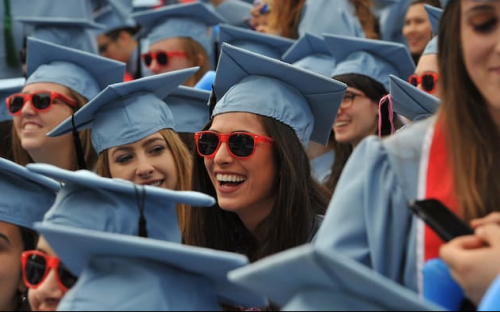Applications are going viral — candidates are prepping Tweet-length descriptions of themselves, videos essays and PowerPoint slides
Getting into a top MBA program is no easy feat.Budding business school students must craft picture-perfect essays, résumés, recommendations and — if they survive the first cull — dazzle admissions committees in interviews.
That’s kept average acceptance rates at the top 10 ranked schools by the Financial Times at a lowly 19.66% this past year, according to a BusinessBecause analysis.
It has, however, gotten a little simpler over the years. Business schools are streamlining their application processes with technology as they strive to target Generation Y, or Millennials — market jargon for a 20-something.
Courting Millennials
“MBA programs are courting Millennials, who have short attention spans and a propensity for not beating about the bush,” says Chioma Isiadinso, chief executive of admissions consultancy Expartus and former assistant director of admissions at Harvard Business School.
This year at Georgetown’s McDonough School of Business, applicants will submit a one-minute video introducing themselves to their potential cohort.
“The admissions process can become so anxiety-ridden that we forget it should be enjoyable. We’ve been trying to make our process as user-friendly and as fun and creative as we can,” says Katelyn Rosa Stephenson, assistant dean of MBA admissions.
This is a departure from the focus on written work, which can be labour intensive. While the traditional essay is still an important component of a solid application, the mantra now is: “Less is more,” says Melissa Rapp, director of full-time admissions at the Kellogg School of Management.
Kellogg has cut the number of written essays it requires from three to two, reduced the word count by a third to just 450 each, and introduced three video-essays.
The hope is that these changes will slash applicants’ workload and spur more top-draw candidates to apply, say admissions consultants. The full-time MBA has arguably lost some of its lustre — figures from the Graduate Management Admissions Council show the number of GMAT entrance tests taken was 247,432 in 2014-15, compared with 265,613 in 2008-09.
But it would be naïve to think the shift has made it any easier to get into business school. Now, would-be MBAs must grapple with technology as business schools tinker with new techniques, says admissions consultant Stacy Blackman.
Applicants are expected to prepare Tweet-length descriptions of themselves, videos and PowerPoint presentations.
And these are just a few examples of a wave of digital innovation in the admissions process, which is altering how business schools assess candidates.
Essays Go Viral
The buzzword now in adcoms is video-essay, which tests applicants in an unscripted environment and assesses their on-the-fly communication and presentation skills. At Toronto’s Rotman School of Management, for instance, applicants sign-in to an online portal and are given a question. After 60 seconds, their webcam begins to record for 90 seconds, during which they must deliver their response.
Sheldon Dookeran, associate director, says the process lets the school’s gatekeepers see how candidates think on their feet.
If that sounds daunting, don’t despair. Dan Bauer, CEO of admissions consultancy The MBA Exchange, says applicants should focus on the meat of their story — not how it’s delivered on screen.
He says: “Don’t be overwhelmed or distracted by lights and cameras; schools want to admit authentic students, not the next Steven Spielberg or Spike Lee.”
Given the proliferation of professional essay-writing and other admissions services, authenticity is becoming increasingly important, notes Georgetown’s Katelyn, “It’s going to be a lot harder to forge a video essay.” She adds: We’re not looking for someone who is trying to submit the video they think we want to see.”
With a crystal clear view of a candidate, schools say they can better assess suit with an MBA program — something that cannot be evaluated through a résumé alone.
Video tests let applicants tell a school more about themselves than they could through only written essays and recommendations, suggests Bruce DelMonico, director of admissions at Yale School of Management, where applicants have 90 seconds to respond to three pre-recorded questions each by video using a webcam.
Video Brings Your Story To Life
Caroline Diarte Edwards, co-director of Fortuna Admissions and the former director of admissions at INSEAD, says: “For candidates who may not have the best profile on paper, the video essay is an opportunity to sell themselves, to bring their story to life.”
A polished video may even give applicants an edge over their competitors, suggests Georgetown’s Katelyn.
She says: “If they submit a notable [video] essay, this may be the reason we bring them in for a face-to-face interview.” She notes that business schools can’t physically meet every applicant — tech is the answer.
“It allows the entire admissions team to meet all of our applicants wherever they are in the world,” says Kellogg’s Melissa.
It’ll at least lighten the workload — Kellogg got 4,300 applications last year alone. This is the reason that more business schools will jump on the tech bandwagon, as Expartus’ Chioma puts it.
INSEAD, for instance, has just added a four-question video test for its 2017 intake, and also culled one required written essay, reducing the total to three.
Would-be MBAs usually spend the summer months swotting entry exams, writing essays, and flattering potential referees. This year, however, they should get ready for their close-up. Technology is the new barrier to admission.
Student Reviews
Georgetown: McDonough School of Business
GWU - excellent investment for future
George Washington University is a good respected institution with strong programs in various studies, including project management, international affairs, politics, medicine and etc. The university provides students with good opportunities for internships and networking.
GWU has a diverse student body and a reputation for academic excellence.
Safety on campus
I have had an amazing experience at Georgetown University. The classes are enjoyable, the professors are exceptional, and I feel like I am receiving a worthwhile education. The people and faculty at this institution are extraordinary, and I have discovered my true self while being here. Additionally, I always feel secure on campus, as it is the safest place in town.
Georgetown is on top!
I've been enjoying this school so far. I wouldn't alter it, despite the fact that the school is on a hill and that it requires a lot of walking to get around it. For minority and first-generation students, there are a ton of services available. Even though the usual dorm rooms are modest, there is still plenty of area for storage. We have a ton of alternatives every day in the dining halls since they provide so many different dishes from so many different cultures
Physical and mental health
Georgetown is my second home. The pre-professional counselors are incredibly helpful, and I feel supported and inspired to pursue my aspirations. We are certainly ranked as the top research university in the nation. They place a high priority on the development of the students as well as their physical and mental well-being.
Wonderful university
Georgetown University is wonderful. The school's amazing diversity is one of its greatest strengths. The athletes are extremely committed to their sport, and the campus is amazing. The dorms are excellent! They are comfortable and spacious. If you ever find yourself bored on campus, you can always go off campus; it's fantastic. You'll never get bored dining in the cafeteria because the food is so delicious on campus.
Academics
The university's academics are what really set it apart; the lecturers are kind and motivating. Although it can be challenging to connect with the majority of students because they are so intense and competitive, social life and student life are what you make of them. It is undoubtedly a very difficult four years that are challenging to get through. But in the end, it strengthens you and provides you with a wealth of knowledge and incredible prospects.
Fantastic university
Georgetown university is a Fantastic university. The professors are outstanding, there are lots of ways to participate in campus life, and there are numerous groups and organizations where students can get involved. The campus is lovely and always kept clean, and there are people are willing to assist you 24 hours a day whenever you need help.
Review of Georgetown university
Being at Georgetown university has been one of my best experiences. The Professors are knowledgeable, approachable, and very helpful. You will fall in love with Georgetown because of its daily activities, the vibrant students you will encounter, the food served on campus, and the lush surroundings. The housing and dorms are fantastic. There is no better place than Georgetown University if you’re looking to study, discover new things, make lifelong friends, and have fun!
Academically challenging institution
Georgetown University is certainly an academically challenging institution, however, if you ask for assistance when you need it, the workload can be managed. Students are happy to assist one another, and most Professor want you to succeed. Student life is vibrant, the location is excellent and everyone here is friendly and welcoming.
4 Years as an Expat at Georgetown University
Georgetown University provided an exceptional environment for my academic journey as an expat from Italy. As someone who initially felt apprehensive about moving to a new country, Georgetown quickly alleviated my concerns and made my transition incredibly smooth.
One of the standout features of Georgetown is its diverse and welcoming community, particularly for international students. The campus is teeming with students from various corners of the globe, fostering a rich cultural tapestry that made me feel right at home. The vibrant campus life and numerous extracurricular activities offered ample opportunities to connect with fellow students, ensuring a well-rounded and fulfilling university experience.
Georgetown's unique setting within the heart of Washington, DC, adds another layer to its charm. While the university is situated in the bustling city, the campus in the historic area of Georgetown provides a distinct and almost intimate atmosphere. This blend creates a truly unique feel and contributes to an unforgettable educational experience.
Initially enrolled in the College with a desire to major in Linguistics and minor in Art & Journalism, I appreciated the flexibility and openness of the Georgetown education system. After my freshman year, I discovered my true passion lay in Marketing and International Business. The university's seamless transfer process allowed me to transition to the McDonough Business School, where I found the perfect fit for my academic aspirations.
Georgetown's commitment to helping students explore and find their academic niche is indeed one of its most commendable qualities. The ability to explore various subjects before settling on a major is a testament to the university's dedication to fostering individual growth and success. The journey from Linguistics to Marketing & International Business exemplifies the beauty of a Georgetown education — a dynamic and supportive environment where students can discover and pursue their true passions.
In conclusion, Georgetown University provided not only a top-notch academic education but also a transformative and enriching experience. From the welcoming international community to the unique campus setting and the flexibility to explore diverse academic paths, Georgetown stands out as a beacon of higher education that truly caters to the individual journey of each student.
My experience at Georgetown university
My time at Georgetown University has been an incredibly enriching and transformative experience. From the moment I stepped onto campus, it was clear that Georgetown offers a unique blend of rigorous academics, vibrant community, and unparalleled opportunities.
Academic Excellence: The academic environment at Georgetown is nothing short of exceptional. The faculty members are not only experts in their fields but are also deeply committed to student success. Their passion for teaching and mentoring has been instrumental in my academic growth. The curriculum is challenging yet rewarding, fostering critical thinking and a global perspective that is essential in today’s world. The emphasis on interdisciplinary studies allowed me to explore a range of subjects and develop a well-rounded understanding of complex issues.
Campus Life: Georgetown’s campus life is vibrant and inclusive. The sense of community is palpable, with a diverse range of student organizations, events, and activities that cater to a variety of interests. From engaging in thought-provoking discussions in seminars to participating in lively campus traditions, there’s never a dull moment. The university’s location in Washington, D.C., provides countless opportunities for internships, networking, and real-world experiences, further enriching the college experience.
Facilities and Resources: The university boasts state-of-the-art facilities that enhance both academic and extracurricular pursuits. The libraries, research centers, and study spaces are well-equipped and conducive to learning. Additionally, the campus itself is beautiful and historic, offering a serene and inspiring environment for students.
Support and Community: One of the standout aspects of Georgetown is the strong sense of community and support. The university fosters a culture of collaboration and mutual respect, creating a nurturing environment where students can thrive. The dedication to student well-being is evident in the various support services available, from academic advising to mental health resources.
Engaging curriculum
Amazing curriculum, staff and overall program. Proud and riveting history. Location is ideal, in the middle of a historic neighborhood in our nations capital. So many things to do and to learn on and off campus.
I love the business section
I would definitely recommend this university. I really like the campus — it has a great atmosphere, modern facilities, and plenty of green spaces. The location is also a big plus, offering a nice balance between city life and a peaceful environment, with everything you need within easy reach.








